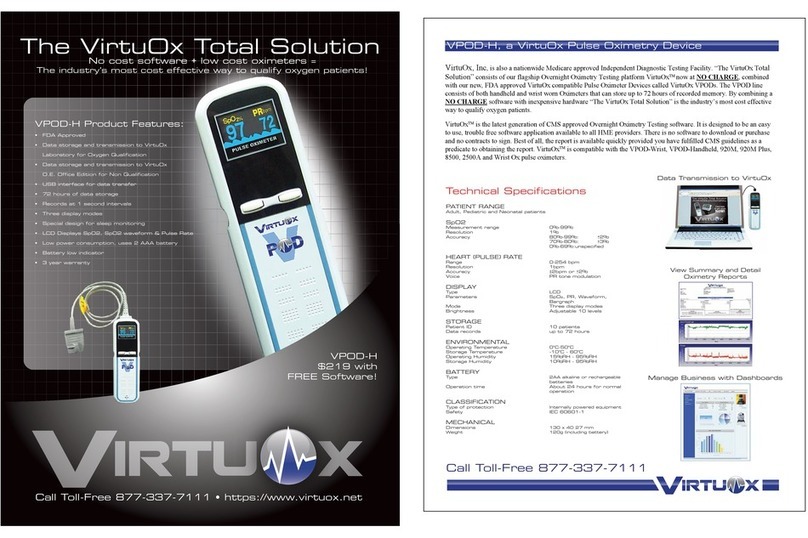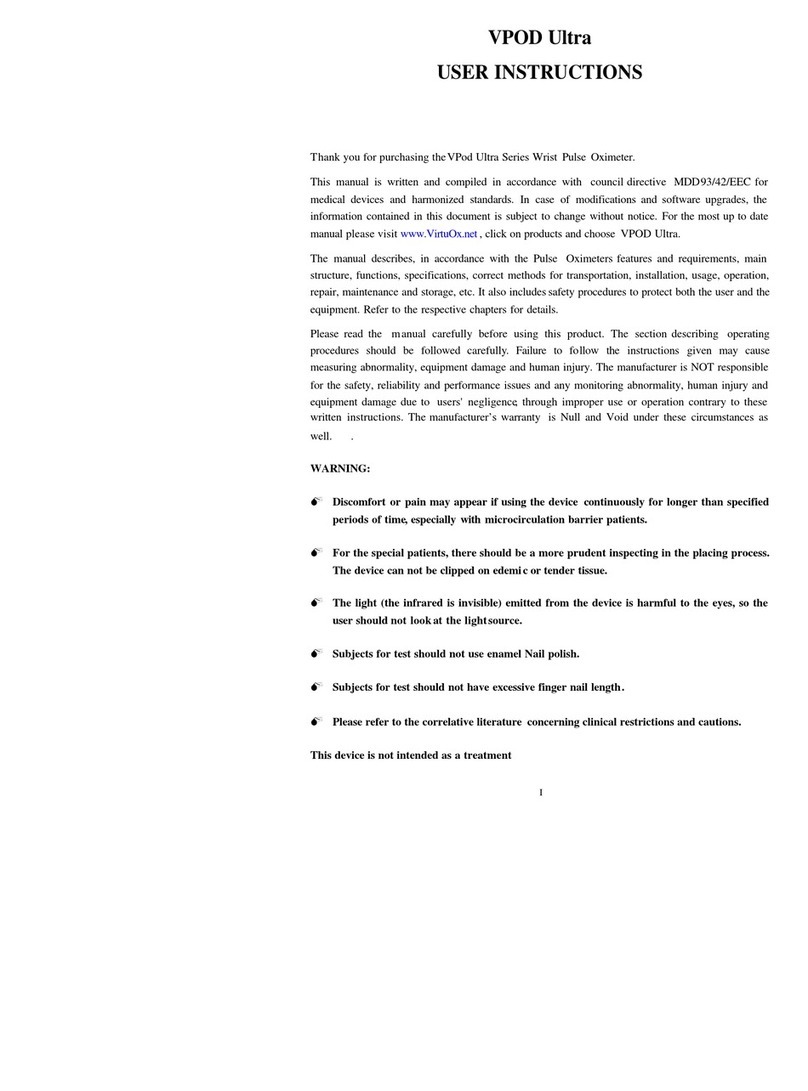
Vpod Instruction Manual
8
wrapping the sensor too tight. Inspect the sensor site to ensure the skin’s integrity and the
adhesion position of the sensor is correct. More frequent inspection should be taken if necessary.
Loss of pulse signal can occur in any of the following situations:
a) The sensor is too tight;
b) There is excessive illumination from light sources such as a surgical lamp, a bilirubin lamp, or
sunlight;
c) A blood pressure cuff is inflated on the same extremity as the one to which an SpO
2
sensor is
attached.
4.4 Display mode
The handheld pulse oximeter uses an OLED display for a readout. It can display the SpO
2
and pulse
rate (PR) value, as well as a pulse column and SpO
2
waveform.
There are three display modes shown in Fig 7. The first figure is pulse column display mode. The
second figure is the waveform mode. The third figure is line waveform mode indicating SpO
2
% trend.
(1) (2) (3)
Fig.7 Three display modes
SpO
2
:Percent oxygen saturation value displayed above is 98%
PR: Pulse rate value displayed is 72 bpm
Fig.7(1) Pulse column: This is used for signal identification and quality indication during motion
and low signal to noise situations. The bar rises and falls with the pulse, its height indicating
signal quality. When the bar is very low, the SpO
2
and pulse rate values may be suspect.
Fig.7(2) Filling-up SpO
2
plethysmogram wave: SpO
2
plethysmogram measurement is
employed to determine the oxygen saturation of hemoglobin in the arterial blood. If , for example,
98% hemoglobin molecules in the red blood cells of the arterial blood combine with oxygen, then
the blood has a SpO
2
oxygen saturation of 98%. The SpO
2
numeric on the Oximeter will read
98%, refer to Fig.7.(2). The SpO
2
numeric shows the percentage of hemoglobin molecules which
have combined with oxygen molecules to form oxyhemoglobin. The SpO
2
plethysmogram
measurement can also provide a plethysmogram wave. During this mode, the PR tone is dumb.
Fig.7(3) SpO
2
plethysmogram wave
PR tone modulation: Beeps in sync with the patient’s pulse, even under most challenging
patient motion conditions.
CHAPTER 5 Other information
5.1 Alarm
Alarm: Technical alarm and physiological alarm.
Technical alarm: finger out, probe off, power low and error code.
In the situation that the finger is not inserted correctly or the connection state of the probe is not good
results in failure of measurement, “Finger out” or ”Sensor off” may be displayed on the normal screen.
When battery power is lower than 2.7±0.1V, the sign will flicker in its display area. Replace the
batteries as soon as possible.
In the failure state, the oximeter will display error codes, and will automatically power off if the error
code display lasts for more than 8 seconds. For the details and definitions on error, please refer to
chapter 4.2.
Physiological alarm: SpO
2
and PR
If the measured SpO
2
and/or PR value is beyond the default limit, alarm will be activated, and the
corresponding value will flash with audio alarm “didi—didi….” .
By default:
SpO
2
: The upper limit: 100%
The lower limit: 90%
PR: The upper limit: 100bpm
The lower limit: 60bpm
Note: during the alarm is issued, long press the functional button, you can silence the alarm for 30
seconds.
5.2 About the button
1) Definition of button
There are three buttons in the oximeter: Power button, Function button and Setting button.
Power button: This acts as a Power On switch when the unit is in an Off condition.
Function Button: When the unit is On, it acts as a Function button.
Setting button: Located at the right of the oximeter, it has no function when the power is off. When
the unit is On, it acts as a Setting button.
2) Definition of Button Press
There are three ways to press the button:
Short Press: press the button quickly, the duration time should no more than 1 second.
Double press: Two-time continuous press, the time between the two press actions should be no more
than 0.5 second.
































